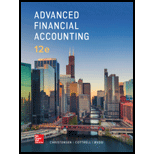
EBK ADVANCED FINANCIAL ACCOUNTING
12th Edition
ISBN: 9781260165104
Author: Christensen
Publisher: YUZU
expand_more
expand_more
format_list_bulleted
Question
Chapter 3, Problem 3.2.3E
To determine
Concept Introduction:
The variable interest entity is the one in which the holding of controlling interest by the investor does not depend on majority of voting rights but on the concept of special purpose entity.
The correct option for the enterprise that absorb a majority of a variable interest entity’s expected loss.
Expert Solution & Answer
Want to see the full answer?
Check out a sample textbook solution
Students have asked these similar questions
I am searching for the correct answer to this general accounting problem with proper accounting rules.
Please explain the solution to this general accounting problem with accurate explanations.
Need answer
Chapter 3 Solutions
EBK ADVANCED FINANCIAL ACCOUNTING
Ch. 3 - What is the basic idea underlying the preparation...Ch. 3 - How might consolidated statements help an investor...Ch. 3 - Prob. 3.3QCh. 3 - Prob. 3.4QCh. 3 - Prob. 3.5QCh. 3 - Prob. 3.6QCh. 3 - Prob. 3.7QCh. 3 - Prob. 3.8QCh. 3 - Prob. 3.9QCh. 3 - Prob. 3.10Q
Ch. 3 - Prob. 3.11QCh. 3 - Prob. 3.12QCh. 3 - What is meant by indirect control? Give an...Ch. 3 - Prob. 3.14QCh. 3 - Prob. 3.15QCh. 3 - Prob. 3.16QCh. 3 - Prob. 3.17QCh. 3 - Prob. 3.18QCh. 3 - Prob. 3.1CCh. 3 - Prob. 3.2CCh. 3 - Prob. 3.1.1ECh. 3 - Prob. 3.1.2ECh. 3 - Prob. 3.1.3ECh. 3 - Prob. 3.1.4ECh. 3 - Multiple-Choice Question on Variable Interest...Ch. 3 - Multiple-Choice Question on Variable Interest...Ch. 3 - Prob. 3.2.3ECh. 3 - Prob. 3.2.4ECh. 3 - Prob. 3.3.1ECh. 3 - Prob. 3.3.2ECh. 3 - Prob. 3.3.3ECh. 3 - Prob. 3.4.1ECh. 3 - Prob. 3.4.2ECh. 3 - Prob. 3.4.3ECh. 3 - Prob. 3.4.4ECh. 3 - Balance Sheet Consolidation On January 1, 20X3,...Ch. 3 - Prob. 3.6ECh. 3 - Prob. 3.7ECh. 3 - Prob. 3.8ECh. 3 - Prob. 3.9ECh. 3 - Reporting for a Variable Interest Entity Gamble...Ch. 3 - Prob. 3.11ECh. 3 - Prob. 3.12ECh. 3 - Prob. 3.13ECh. 3 - Prob. 3.14ECh. 3 - Prob. 3.15ECh. 3 - Prob. 3.16ECh. 3 - Prob. 3.17ECh. 3 - Prob. 3.18ECh. 3 - Prob. 3.19.1PCh. 3 - Prob. 3.19.2PCh. 3 - Prob. 3.20PCh. 3 - Prob. 3.21PCh. 3 - Prob. 3.22PCh. 3 - Prob. 3.23PCh. 3 - Prob. 3.24PCh. 3 - Prob. 3.25PCh. 3 - Prob. 3.26PCh. 3 - Prob. 3.27PCh. 3 - Prob. 3.28PCh. 3 - Prob. 3.29PCh. 3 - Consolidated Worksheet at End of the First Year of...Ch. 3 - Prob. 3.31P
Knowledge Booster
Similar questions
- What is the amount of overhead at the end of the year?arrow_forwardGreenfield Corporation budgeted 3,500 pounds of material costing $6.80 per pound to produce 1,500 units. The company actually used 4,200 pounds which cost $7.10 per pound to produce 1,500 units. What is the direct materials price variance?arrow_forwardCan you solve this financial accounting question with accurate accounting calculations?arrow_forward
arrow_back_ios
SEE MORE QUESTIONS
arrow_forward_ios
Recommended textbooks for you
- Principles of Accounting Volume 2AccountingISBN:9781947172609Author:OpenStaxPublisher:OpenStax College
 Intermediate Financial Management (MindTap Course...FinanceISBN:9781337395083Author:Eugene F. Brigham, Phillip R. DavesPublisher:Cengage LearningPrinciples of Accounting Volume 1AccountingISBN:9781947172685Author:OpenStaxPublisher:OpenStax College
Intermediate Financial Management (MindTap Course...FinanceISBN:9781337395083Author:Eugene F. Brigham, Phillip R. DavesPublisher:Cengage LearningPrinciples of Accounting Volume 1AccountingISBN:9781947172685Author:OpenStaxPublisher:OpenStax College  EBK CONTEMPORARY FINANCIAL MANAGEMENTFinanceISBN:9781337514835Author:MOYERPublisher:CENGAGE LEARNING - CONSIGNMENT
EBK CONTEMPORARY FINANCIAL MANAGEMENTFinanceISBN:9781337514835Author:MOYERPublisher:CENGAGE LEARNING - CONSIGNMENT Financial Reporting, Financial Statement Analysis...FinanceISBN:9781285190907Author:James M. Wahlen, Stephen P. Baginski, Mark BradshawPublisher:Cengage Learning
Financial Reporting, Financial Statement Analysis...FinanceISBN:9781285190907Author:James M. Wahlen, Stephen P. Baginski, Mark BradshawPublisher:Cengage Learning

Principles of Accounting Volume 2
Accounting
ISBN:9781947172609
Author:OpenStax
Publisher:OpenStax College

Intermediate Financial Management (MindTap Course...
Finance
ISBN:9781337395083
Author:Eugene F. Brigham, Phillip R. Daves
Publisher:Cengage Learning

Principles of Accounting Volume 1
Accounting
ISBN:9781947172685
Author:OpenStax
Publisher:OpenStax College


EBK CONTEMPORARY FINANCIAL MANAGEMENT
Finance
ISBN:9781337514835
Author:MOYER
Publisher:CENGAGE LEARNING - CONSIGNMENT

Financial Reporting, Financial Statement Analysis...
Finance
ISBN:9781285190907
Author:James M. Wahlen, Stephen P. Baginski, Mark Bradshaw
Publisher:Cengage Learning